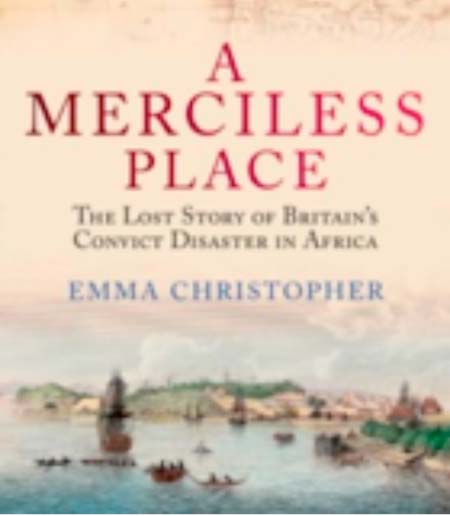
It
is a rare pleasure to review a book that will appeal not only to the specialist
in the field, but also to the general reader. A Merciless Place is such a book,
a work of original scholarship that clearly indicates years of hard labour in
the archives, and also a beautifully crafted literary endeavour, one that
should attract anyone who appreciates excellent writing.
For more than a century, England used its North American colonies as a dumping ground for its unwanted criminals. Societies without prisons generally rely on physical punishment and exile as punishment for all levels of crime. England had used branding, beating, mutilation, and the death penalty for centuries. On paper, British law relied heavily on the latter penalty for all sorts of crimes, from petty theft to the most heinous acts of violence. By the latter half of the eighteenth century, England had some 225 capital offenses on the books. However, as many historians have pointed out, juries hesitated to convict if they believed that a minor crime against property would result in the death penalty. The legal system relieved that stress through the ingenious mechanism of the king’s pardon commuting the death penalty into transportation to the colonies. Few people objected to shipping common criminals off to North America, with more than fifty thousand having been transported to the American colonies by 1775. Transportation not only relieved the English of thousands of criminals, but it also allowed them to treat their American cousins with contempt, as when Samuel Johnson declared the Americans “a race of convicts, and ought to be thankful for anything we allow them short of hanging.”
The Americans were not consulted on this creative legal structure, but they gave their opinion on many occasions, and it was decidedly negative. In 1759 Benjamin Franklin publicly complained that the policy was “an insult and contempt, the cruellest perhaps that ever one people offered another”. He suggested that it would only be fair for the colonies to ship rattlesnakes to Britain in exchange. The American Revolution created a crisis for the British legal system, which had a serious backlog of criminals sentenced to transportation with nowhere to send them. Emma Christopher of the University of Sydney gets to the obvious but previously unstudied question: what did Britain do with its criminals when the United States came into existence? It is well known that eventually the British government decided to use Australia as a home for its undesirables, but I hate to admit that it never occurred to me to wonder what happened to its criminals between 1776 and 1788. Christopher provides the answer in fascinating detail.
After the American Revolution London’s jails were bulging with men and women sentenced to death. Lacking America as an alternative punishment, the courts proceeded with executions in “an orgy of public slaughter,” the number of hangings in Middlesex doubling between 1780 and 1785. Hundreds of sleight-of-hand artists and petty criminals became caught up in a wild scheme of the government to dispose of its convicts in the unlikeliest of places. Trying anything to avoid the overuse of the death penalty yet faced with overcrowded prisons, the government decided to try transporting their prisoners to some other remote location, though in a rather nonchalant fashion. It decided to ship the lot of them off somewhere--an attitude that would probably find many adherents in modern America.
Captains Kenneth Mackenzie and George Katenkamp sought to attain glory and position fighting His Majesty’s war against the American rebels. They gained permission from the War Office to raise two Independent Companies, reluctantly accepting the enlistment of more than one hundred convicted criminals. There were a few true scoundrels in the mix, most notoriously William Murray, a professional con artist and thief who had escaped the gallows on several occasions. But most of these “recruits” had been incarcerated and often sentenced to death for minor offenses. For instance, John Plunkett, who had stolen three mirrors, thought serving in the army could not be worse than His Majesty’s prison ships, especially if he would be doing that service in North America. But on the day they set sail, the members of the Independent Companies discovered that they had been tricked by their government and were bound for Africa.
With the collapse of Britain’s North American empire, Africa had become the new focus of British greed and imperial schemes. But the British “died in droves,” and the War Office quickly found it difficult to man their African outposts--thus the logic of sending convicts rather than regulars who would be better employed in safer climes.
Slaves remained the major source of British wealth in Africa, the slave trade under the control of the Royal African Company but they absolutely did not want the convict soldiers. Racial attitudes complicated the effort to place criminals in positions of both authority and servility in major slave-trading centers; the Royal African Company warned that they would undermine the proclaimed racial superiority of Englishmen. Governor Richard Miles wrote from his headquarters at Cape Coast Castle that these convicts were a “Disgrace to the very Colour”. He knew full well that the African merchants and monarchs were not the powerless figures portrayed in imperial propaganda, but capable of crushing the English slave trade if they ceased fearing British troops. Reinforcing Miles’s concern, the convicts arrived at Cape Coast Castle on the Brookes, the slave ship made notorious by William Elford’s much-reproduced diagram of the ship’s hold crammed with slaves. It was not an auspicious beginning to this latest experiment in criminal justice.
Much of Christopher’s book is devoted to telling the bizarre story of the fate of these convicts--men and women--who travelled unwillingly to the coast of Africa. The reader shares the researcher’s sense of wonder as she explores yet another outrageous aspect of Britain’s transportation policy.
It is worth noting Christopher’s larger point, that the British government acted to solve a domestic problem by sending convicts overseas without any planning, lacking even a “specific destination”. No step of this operation seems to have been thought through, as the convicts were dropped off without food or supplies at remote imperial outposts. The result, as many contemporaries predicted, was a catastrophe for those involved, making Africa synonymous with death. The Lord Mayor of Plymouth, John Nicol, challenged the Home Office over its use of “so severe a Sentence as that of Transportation [to] the Coast of Africa,” which was tantamount to a death sentence.
Christopher takes a number of informative detours into other dark corners of the empire, such as the corrupt rule of Governor Joseph Wall on the island of Gorée--another convict dumping ground on the coast of Africa that ended in a “reign of terror”. After the failure of the Africa plan, the government tried America again, which led to two mutinies, an inability to find buyers of the criminals’ indentures, and outrage from the new U.S. government. Returning to Africa in 1785, the transportation of criminals there again proved a debacle, as did the disastrous settlement of black Loyalists in Sierra Leone. A proposal to develop South Africa with convicts in order to make up for the loss of the American colonies also went pear shape.
Christopher writes beautifully and with wit, personalizing this tragic history with outstanding character sketches. There are also a number of evocative set pieces, such as her description of public executions, the hell of British prison ships, and the environment of west Africa. She concludes her book with Australia, the settlement of which takes on new meaning in the context of these previous efforts to deal with a deeply flawed legal system. After all, Australia was first suggested as an appropriate dumping ground before the Lemane Commission, which was looking into a harebrained scheme for convicts to grow wheat on an island in the Gambia River.
Christopher moves beyond traditional legal studies to give us a vision of the law’s impact on the individual lives of the powerless and marginalized. She asks us to imagine the consequences for a young man or woman who steals a handkerchief or loaf of bread and is sentenced to transportation to the coast of Africa. Thoroughly researched, brilliantly written, deeply humane, A Merciless Place is a model of modern legal scholarship.
Available at Timbooktoo, tel 4494345



